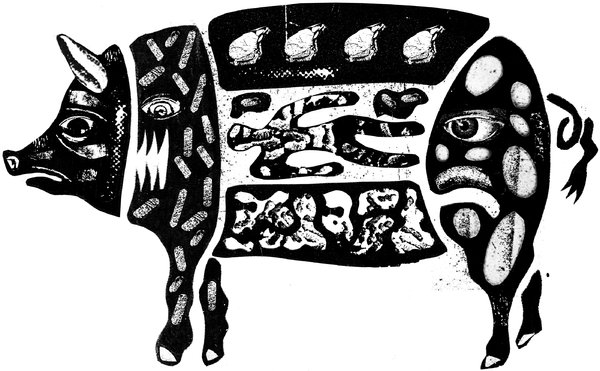Making a Pig’s Ear of Food Safety, By TED GENOWAYS
Making a Pig’s Ear of Food Safety
By TED GENOWAYS DEC. 12, 2014
Photo
Credit Ben Jones
LINCOLN, Neb. — IF, thanks to an experimental inspection program, a meatpacking firm produces as much as two tons a day of pork contaminated by fecal matter, urine, bile, hair, intestinal contents or diseased tissue, should that count as a success?
The agency responsible for enforcing food safety laws has not only approved this new inspection regime but is considering whether to roll it out across the pork-processing industry. Last month, the Food Safety and Inspection Service of the United States Department of Agriculture said it wished to see if the pilot program “could be applied to additional establishments.”
The project dates back to 1993, when more than 500 Americans were made sick by E. coli traced to tainted hamburgers. In response, the industry’s largest trade association, the American Meat Institute, proposed a new system of microbiological testing in packinghouses as part of an inspection protocol known as Hazard Analysis and Critical Control Points. The approach resembles a system developed by NASA and Pillsbury for ensuring food safety aboard spaceflights.
The new program sounded good in theory, but existing systems mandated manual inspections of all carcasses by trained federal inspectors. The hazard analysis model would give meatpackers the leading role in inspections; the U.S.D.A. would be relegated to spot-checking selected carcasses. Some inspectors joked that H.A.C.C.P. stood for “Have a Cup of Coffee and Pray.”
The issue was not whether microbiological testing was superior to physical inspection, officials said, but whether self-regulation was sufficient and safe. But in 1997, U.S.D.A. executives approved testing in five pork-processing plants.
By the time the pilot program was fully implemented, in 2004, Hormel Foods Corporation, a Fortune 500 company with headquarters in Austin, Minn., had succeeded in getting its two major slaughter operations included, and had acquired a third. The new inspection system allowed Hormel to increase the speed of its cut lines, just before demand for cheap pork products like Spam soared during the recession. My reporting revealed that Hormel went from processing about 7,000 hogs per shift to as many as 11,000.
But some of Hormel’s own quality-assurance auditors began to raise concerns. Under normal U.S.D.A. guidelines, inspectors manually check the glands in the head of every hog, palpate the lymph nodes to check for tuberculosis nodules, feel the intestines for parasites and the kidneys for signs of inflammation or hidden masses. A former process-control auditor from the Austin plant told me that, by 2006, the line was running so fast that he doubted the lone U.S.D.A. inspector could do more than visual checks.
Then, last year, the U.S.D.A. inspector general reported on the hazard analysis project. The findings were damning. Enforcement of food safety protocols was so lacking at the five plants participating that between 2008 and 2011, three of the five were among the 10 worst violators nationwide (of 616 pork processors).
Philip Derfler, deputy administrator of the inspection service, promised a further investigation. That report was finally posted last month. Remarkably, it painted the new inspection program as a success — though much of its data suggested otherwise. From 2006 to 2010, for example, fecal contamination was consistently higher than in standard plants, often much higher.
In 2011, however, the program changed from allowing meat inspectors to decide which carcasses to inspect to a computerized system that set the sampling schedule and recorded results electronically. The system failed repeatedly that year, rendering all data unusable. Inspectors also reported failures in 2012 and 2013 that sent at least 100 million pounds of uninspected meat to market.
Despite this, in 2013, the rate of contamination recorded by the new computer system appeared low enough for the inspection service to declare victory. The new report said the number of serious violations was “exceedingly small.”
In fact, over the course of the study, contaminated carcasses were found in the experimental plants at a rate of about five to seven animals per 10,000 processed, with little variation over time. That may sound low, but given the volume of production and the weight of market hogs, it means that an operation the size of Hormel’s would “approve” about 4,000 pounds of contaminated pork a day.
And that’s only what U.S.D.A. inspectors have found by spot checks; the actual numbers may be higher. Bad meat not selected for random double-checking by inspectors could be reaching the table. That risk is why, under federal law, there is zero tolerance for such violations. It’s hard to say if traditional plants are achieving that mark, because, as the Government Accountability Office noted, the inspection service “did not collect comparable data” and “did not adequately oversee the program.” Yet the U.S.D.A. argues for using the inspection model in other plants despite its flawed numbers.
The U.S.D.A. inspector general and the G.A.O. must intervene before that can happen, by investigating how data were collected and tabulated in this new report and reviewing the program’s expansion. After that, the president should order an inquiry into the entire meat industry. The American public must be assured that high-volume production — and profits — have not been put before food safety.
Ted Genoways is the author of “The Chain: Farm, Factory, and the Fate of Our Food.”
A version of this op-ed appears in print on December 13, 2014, on page A19 of the New York edition with the headline: Making a Pig’s Ear of Food Safety. Order Reprints| Today’s Paper|Subscribe
